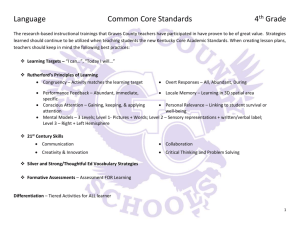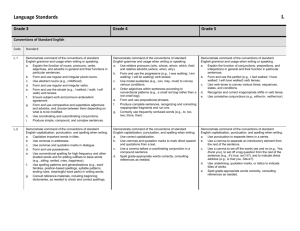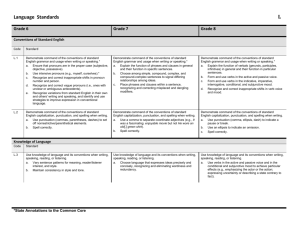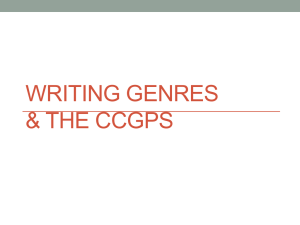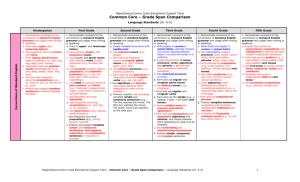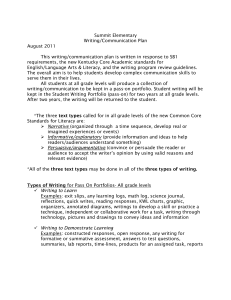First Grade
advertisement
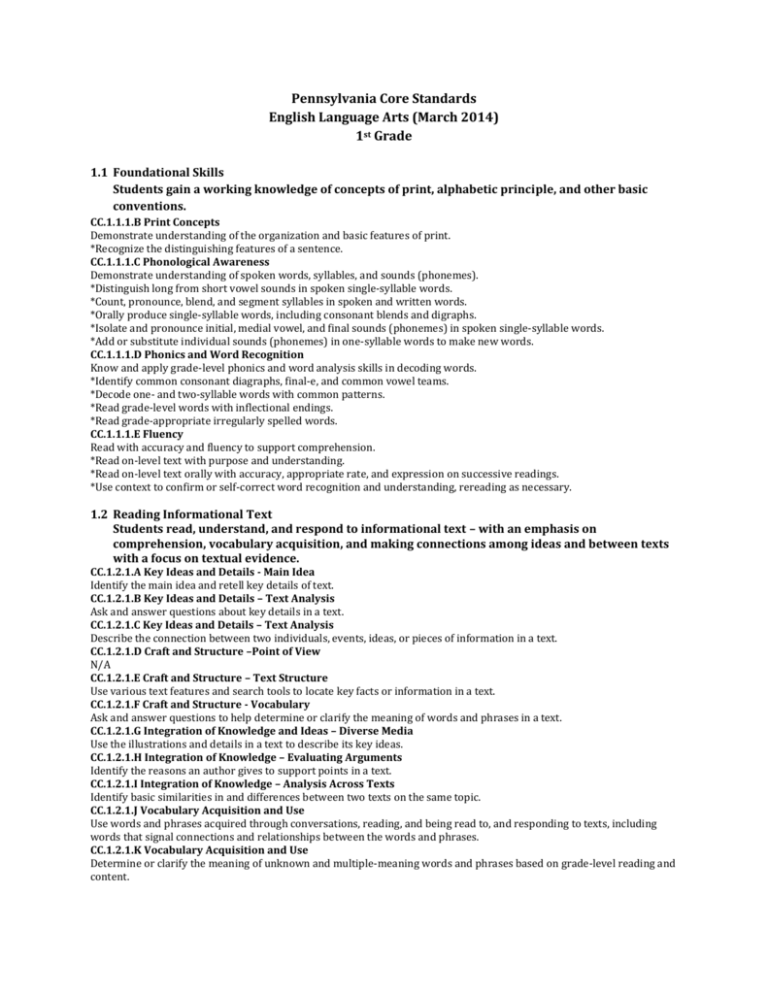
Pennsylvania Core Standards English Language Arts (March 2014) 1st Grade 1.1 Foundational Skills Students gain a working knowledge of concepts of print, alphabetic principle, and other basic conventions. CC.1.1.1.B Print Concepts Demonstrate understanding of the organization and basic features of print. *Recognize the distinguishing features of a sentence. CC.1.1.1.C Phonological Awareness Demonstrate understanding of spoken words, syllables, and sounds (phonemes). *Distinguish long from short vowel sounds in spoken single-syllable words. *Count, pronounce, blend, and segment syllables in spoken and written words. *Orally produce single-syllable words, including consonant blends and digraphs. *Isolate and pronounce initial, medial vowel, and final sounds (phonemes) in spoken single-syllable words. *Add or substitute individual sounds (phonemes) in one-syllable words to make new words. CC.1.1.1.D Phonics and Word Recognition Know and apply grade-level phonics and word analysis skills in decoding words. *Identify common consonant diagraphs, final-e, and common vowel teams. *Decode one- and two-syllable words with common patterns. *Read grade-level words with inflectional endings. *Read grade-appropriate irregularly spelled words. CC.1.1.1.E Fluency Read with accuracy and fluency to support comprehension. *Read on-level text with purpose and understanding. *Read on-level text orally with accuracy, appropriate rate, and expression on successive readings. *Use context to confirm or self-correct word recognition and understanding, rereading as necessary. 1.2 Reading Informational Text Students read, understand, and respond to informational text – with an emphasis on comprehension, vocabulary acquisition, and making connections among ideas and between texts with a focus on textual evidence. CC.1.2.1.A Key Ideas and Details - Main Idea Identify the main idea and retell key details of text. CC.1.2.1.B Key Ideas and Details – Text Analysis Ask and answer questions about key details in a text. CC.1.2.1.C Key Ideas and Details – Text Analysis Describe the connection between two individuals, events, ideas, or pieces of information in a text. CC.1.2.1.D Craft and Structure –Point of View N/A CC.1.2.1.E Craft and Structure – Text Structure Use various text features and search tools to locate key facts or information in a text. CC.1.2.1.F Craft and Structure - Vocabulary Ask and answer questions to help determine or clarify the meaning of words and phrases in a text. CC.1.2.1.G Integration of Knowledge and Ideas – Diverse Media Use the illustrations and details in a text to describe its key ideas. CC.1.2.1.H Integration of Knowledge – Evaluating Arguments Identify the reasons an author gives to support points in a text. CC.1.2.1.I Integration of Knowledge – Analysis Across Texts Identify basic similarities in and differences between two texts on the same topic. CC.1.2.1.J Vocabulary Acquisition and Use Use words and phrases acquired through conversations, reading, and being read to, and responding to texts, including words that signal connections and relationships between the words and phrases. CC.1.2.1.K Vocabulary Acquisition and Use Determine or clarify the meaning of unknown and multiple-meaning words and phrases based on grade-level reading and content. CC.1.2.1.L Range of Reading Read and comprehend literary nonfiction and informational text on grade level, reading independently and proficiently. 1.3 Reading Literature Students read and respond to works of literature—with emphasis on comprehension, vocabulary acquisition, and making connections among ideas and between texts with focus on textual evidence. CC.1.3.1.A Key Ideas and Details - Theme Retell stories, including key details, and demonstrate understanding of their central message or lesson. CC.1.3.1.B Key Ideas and Details – Text Analysis Ask and answer questions about key details in a text. CC.1.3.1.C Key Ideas and Details – Literary Elements Describe characters, settings, and major events in a story, using key details. CC.1.3.1.D Craft and Structure – Point of View Identify who is telling the story at various points in a text. CC.1.3.1.E Craft and Structure – Text Structure Explain major differences between books that tell stories and books that give information, drawing on a wide reading or range of text types. CC.1.3.1.F Craft and Structure - Vocabulary Identify words and phrases in stories or poems that suggest feelings or appeal to the senses. CC.1.3.1.G Integration of Knowledge and Ideas – Sources of Information Use illustrations and details in a story to describe characters, setting, or events. CC.1.3.1.H Integration of Knowledge and Ideas – Text Analysis Compare and contrast the adventures and experiences of characters in stories. CC.1.3.1.I Vocabulary Acquisition and Use - Strategies Determine or clarify the meaning of unknown and multiple-meaning words and phrases based on grade-level reading and content. CC.1.3.1.J Vocabulary Acquisition and Use Use words and phrases acquired through conversations, reading, and being read to, and responding to texts, including words that signal connections and relationships between the words and phrases. CC.1.3.1.K Range of Reading Read and comprehend literature on grade level, reading independently and proficiently. 1.4 Writing Students write for different purposes and audiences. Students write clear and focused text to convey a well-defined perspective and appropriate content. CC.1.4.1.A Informative/Explanatory Write informative/ explanatory texts to examine a topic and convey ideas and information. CC.1.4.1.B Informative/Explanatory - Focus Identify and write about one specific topic. CC.1.4.1.C Informative/Explanatory - Content Develop the topic with two or more facts. CC.1.4.2.D Informative/Explanatory - Organization Group information and provide some sense of closure. CC.1.4.1.E Informative/Explanatory - Style Choose words and phrases for effect. CC.1.4.1.F Informative/Explanatory – Conventions of Language Demonstrate a grade-appropriate command of the conventions of standard English grammar, usage, capitalization, punctuation, and spelling. *Capitalize dates and names of people. *Use end punctuation; use commas in dates and words in series. *Spell words drawing on common spelling patterns, phonemic awareness, and spelling conventions. CC.1.4.1.G Opinion/Argumentative Write opinion pieces on familiar topics. CC.1.4.1.H Opinion/Argumentative - Focus Form an opinion by choosing among given topics. CC.1.4.1.I Opinion/Argumentative - Content Support the opinion with reasons related to the opinion. CC.1.4.1.J Opinion/Argumentative - Organization Create an organizational structure that includes reasons and provides some sense of closure. CC.1.4.1.K Opinion/Argumentative - Style Use a variety of words and phrases. CC.1.4.1.L Opinion/Argumentative – Conventions of Language Demonstrate a grade-appropriate command of the conventions of standard English grammar, usage, capitalization, punctuation, and spelling. *Capitalize dates and names of people. *Use end punctuation; use commas in dates and words in series. *Spell words drawing on common spelling patterns, phonemic awareness, and spelling conventions. CC.1.4.1.M Narrative Write narratives to develop real or imagined experiences or events. CC.1.4.1.N Narrative - Focus Establish who and what the narrative will be about. CC.1.4.1.O Narrative - Content Include thoughts and feelings to describe experiences and events. CC.1.4.1.P Narrative - Organization Recount two or more appropriately sequenced events using temporal words to signal event order and provide some sense of closure. CC.1.4.1.Q Narrative - Style Use a variety of words and phrases. CC.1.4.1.R Narrative – Conventions of Language Demonstrate a grade-appropriate command of the conventions of standard English grammar, usage, capitalization, punctuation, and spelling. *Capitalize dates and names of people. *Use end punctuation; use commas in dates and words in series. *Spell words drawing on common spelling patterns, phonemic awareness, and spelling conventions. CC.1.4.1.S Response to Literature N/A CC.1.4.1.T Production and Distribution of Writing/Writing Process With guidance and support from adults and peers, focus on a topic, respond to questions and suggestions from peers and add details to strengthen writing as needed. CC.1.4.1.U Technology and Publication With guidance and support, use a variety of digital tools to produce and publish writing including in collaboration with peers. CC.1.4.1.V Conducting Research Participate in individual or shared research and writing projects. CC.1.4.1.W Credibility, Reliability, and Validity of Sources With guidance and support, recall information from experiences or gather information from provided sources to answer a question. CC.1.4.1.X Range of Writing Write routinely over extended time frames (time for research, reflection, and revision) and shorter time frames (a single sitting or a day or two) for a range of discipline-specific tasks, purposes, and audiences. 1.5 Speaking and Listening Students present appropriately in formal speaking situations, listen critically, and respond intelligently as individuals or in group discussions. CC.1.5.1.A Comprehension and Collaboration – Collaborative Discussion Participate in collaborative conversations with peers and adults in small and larger groups. CC.1.5.1.B Comprehension and Collaboration – Critical Listening Confirm understanding of a text read aloud or information presented orally or through other media by asking and answering questions about key details and requesting clarification if something is not understood. CC.1.5.1.C Comprehension and Collaboration – Evaluating Information Ask and answer questions about what a speaker says in order to gather additional information or clarify something that is not understood. CC.1.5.1.D Presentation of Knowledge and Ideas – Purpose, Audience and Task Describe people, places, things, and events with relevant details, expressing ideas and feelings clearly. CC.1.5.1.E Presentation of Knowledge and Ideas - Content Produce complete sentences when appropriate to task and situation. CC.1.5.1.F Integration of Knowledge and Ideas - Multimedia Add drawings or other visual displays when sharing aloud to clarify ideas, thoughts, and feelings. CC.1.5.1.G Conventions of Standard English Demonstrate command of the conventions of standard English when speaking, based on Grade 1 level and content.
